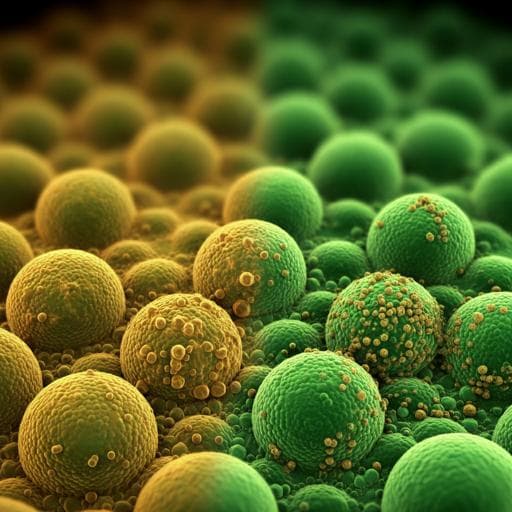
Agriculture
A rare gain of function mutation in a wheat tandem kinase confers resistance to powdery mildew
P. Lu, L. Guo, et al.
Discover how a rare genetic mutation in a tandem kinase protein is paving the way for powdery mildew resistance in wheat. This groundbreaking research, conducted by a team of experts, reveals the vital role of the *Pm24* gene derived from the Chinese landrace Hulutou. Uncover the future of wheat disease resistance through this significant advancement in plant genetics.
~3 min • Beginner • English
Introduction
Wheat provides roughly 20% of daily human calories and protein, but diseases such as powdery mildew (caused by Blumeria graminis f. sp. tritici, Bgt) threaten global production. Many race-specific resistance genes rapidly lose effectiveness due to pathogen evolution. Although over 100 Pm resistance genes/alleles have been documented, few have been cloned; most cloned Pm genes encode NLR proteins that are often defeated by new pathogen races. Durable partial resistance genes encode transporters (e.g., Lr34/Yr18/Pm38 and Lr67/Yr46/Pm46). Wheat landraces are a rich source of resistance; Pm24 (Chiyacao), Pm24b (Baihulu), and MIHLT (Hulutou) were mapped to chromosome arm 1DS. The study aimed to clone Pm24/MIHLT, define its molecular basis, and explore its natural allelic variation and mechanism in conferring powdery mildew resistance.
Literature Review
Prior work documented numerous Pm genes across 63 loci (Pm1–Pm66), but only a few have been cloned (e.g., Pm28, Pm39, Pm8, Pm21, Pm38/Lr34/Yr18/Sr57, Pm46/Lr67/Yr46/Sr55, Pm60). Most encode NLRs prone to race-specific defeat, with Pm8 being a notable example of breakdown in widespread use. Durable partial resistance genes Pm38 and Pm46 encode transporters. Landrace-derived Pm genes such as Pm5d, Pm5e, Pm24, Pm24b, Pm45, Pm47, Pm61, Pm59, and Pm63 were identified but largely uncloned, limiting mechanistic understanding and breeding deployment. Tandem kinase proteins (TKPs) have emerged as a plant disease resistance family (e.g., wheat Yr15/WTK1, wheat Sr60/WTK2, barley Rpg1, barley Un8). Receptor-like cytoplasmic kinases (RLCKs) such as Pto and BIK1 function in PRR-mediated immunity, and Stpk-V is implicated in Pm21-mediated resistance. This context motivated cloning and functional dissection of Pm24/WTK3.
Methodology
- Genetic materials and mapping: An F2 mapping population (n=3,720 plants; 7,440 gametes) was generated from resistant landrace Hulutou (HLT) × susceptible cultivar Shi 4185 (S4185). MIHLT was previously mapped to 1DS. Flanking STS markers were BLASTed to the Aegilops tauschii genome to develop closer markers. SSR markers WGGB240 and WGGB245 identified 36 recombinants; additional markers (WGGB241, WGGB242, WGGB243 dCAPS, WGGB244 SNP) delimited MIHLT to 0.06 cM corresponding to a 532 kb interval. Gene models in the interval (WTK3, RLK1, RLK2, CNL, HP, RP) were annotated.
- Candidate gene sequencing and expression: Expression of interval genes in seedlings of HLT and S4185 was profiled by RT-PCR. Full-length cDNAs for WTK3 and CNL were obtained by 5′/3′ RACE and sequenced from both genotypes to identify SNPs/InDels.
- Transgenic validation: Three constructs were assembled: ProWTK3:WTK3 (15,599 bp genomic fragment with 3,378 bp promoter, full gene, 1,811 bp terminator), ProCNL:CNL (9,704 bp genomic fragment with 3,064 bp promoter, gene, 2,476 bp terminator), and ProUbi:WTK3 (maize Ubi promoter driving WTK3HLT.IF1 CDS). Agrobacterium-mediated transformation into susceptible wheat cv. Fielder generated multiple independent T0/T1 lines. Presence and expression were confirmed by PCR/RT-PCR.
- EMS mutagenesis: Approximately 15,000 HLT seeds were EMS-treated (0.5% v/v, 16 h) to generate 1,360 M1 plants; M2 families (35–40 plants each) were screened with Bgt isolate E09. Twenty-six independent susceptible lines were identified; full WTK3 and CNL genomic regions (promoters, exons/introns, terminators) were sequenced in susceptible mutants to identify causative mutations.
- Pathogen assays and cytology: Two-leaf stage seedlings inoculated with Bgt isolate E09 (and additional isolates) were scored at 10 dpi on a 0–4 infection type scale. H2O2 accumulation was detected with DAB staining at 48 hpi; cell death and fungal structures visualized with Trypan blue at 7 dpi.
- Gene expression analyses: qRT-PCR assessed WTK3 and six PR genes (PR1, PR2, PR3, PR4, PR5, PR9) at 0, 4, 12, 24, 36, 48 hpi in HLT and S4185; ACTIN served as control; 2^−ΔΔCT method used with triplicates.
- Haplotype and allelism analyses: Reciprocal crosses among landraces CYC (Pm24), BHL (Pm24b), and HLT (MIHLT) tested allelism. WTK3 genomic sequences (entire 15,599 bp) were amplified from CYC and BHL. A 632 bp STS spanning the 6-bp InDel was used to genotype 1,069 accessions (Chinese mini-core, Chinese and worldwide landraces, two modern cultivars, and 87 Ae. tauschii) for haplotype analysis; sequences were aligned to define haplotypes (Hap I–X). A Pm24-specific STS marker (STS-Pm24) was designed.
- Functional testing of the 6-bp deletion: Chimeric WTK3 variants with alternative deletions at the same region were constructed under Ubi promoter: WTK3#1 (3-bp deletion removing K400), WTK3#2 (3-bp deletion removing G401), and WTK3#3 (12-bp deletion removing K399_W402). Transgenic Fielder T1 plants were challenged with Bgt E09.
- Phylogenetics: Kinase/pseudokinase domains from TKPs across grasses and model plants were aligned (SMART, Clustal Omega) and neighbor-joining trees built (iTOL) to infer relationships of WTK3 Kin I/II to other TKPs.
- Data and statistics: Linkage mapping used Mapmaker 3.0 with Kosambi function and LOD ≥3.0. Expression differences evaluated by Student’s t-test (e.g., WTK3HLT vs WTK3S4185 at 36 hpi, P<0.01).
Key Findings
- Pm24, Pm24b, and MIHLT are allelic/tightly linked: All F2 plants from reciprocal crosses among CYC, BHL, and HLT (each cross >4,300 F2 plants) were resistant to Bgt E09. The three landraces were resistant (IT 0–2) to 93 genetically diverse Bgt isolates from 12 Chinese provinces.
- High-resolution mapping: MIHLT was narrowed to a 0.06 cM interval (532 kb) on 1DS between WGGB241 and WGGB244, co-segregating with WGGB242 and WGGB243.
- Candidate genes: The interval contained WTK3 (tandem kinase), RLK1, RLK2, a CNL, a hypothetical protein, and RP L10. Only WTK3 and CNL showed sequence polymorphisms between HLT and S4185.
- WTK3 structural polymorphism: HLT WTK3 harbors a 6-bp deletion in exon 5 (AAAGGA) resulting in deletion of two amino acids (K400G401) in the Kin I domain; a C/G intronic SNP was also observed. In S4185, CNL carries a nonsense mutation; however, functional assays did not support CNL as causal.
- Transgenic validation: Fielder plants carrying ProWTK3:WTK3 or ProUbi:WTK3HLT.IF1 were highly resistant to Bgt E09 (IT 0) across 7 and 12 independent T1 families, respectively; ProCNL:CNL transgenics remained susceptible (IT 4) across 14 T1 families, demonstrating WTK3 is sufficient to confer resistance.
- EMS mutant evidence: Among 26 independent susceptible EMS families from HLT, 11 had mutations exclusively in WTK3 (nonsense, missense, or splice-site) mapping to conserved subdomains of Kin I (e.g., E372K in VIII; G389S in IX) and Kin II (e.g., A600T in III; G718R at activation loop border; R834K, P835S in XI), indicating WTK3 is required and both kinase domains are functionally important. Two nonsense mutations (W429*, W478*) abolished function; one splice acceptor mutation caused frameshift.
- Expression dynamics: WTK3 was expressed in root, stem, and leaf; after Bgt inoculation, WTK3 transcripts increased ~6-fold, peaking at 24 hpi. WTK3HLT expression exceeded WTK3S4185 at 36 hpi (P<0.01). PR genes were upregulated later, suggesting WTK3 acts upstream.
- Allelic identity of Pm24/Pm24b/MIHLT: Complete WTK3 sequences from CYC and BHL were identical to HLT, confirming the same allele underlies Pm24, Pm24b, and MIHLT.
- Haplotype survey: Sequencing the 632 bp region across 1,069 accessions revealed 10 haplotypes; the 6-bp deletion was present only in four Chinese landraces (CYC, BHL, HLT, Hongmangmai) and in none of the remaining 1,065 accessions (including Ae. tauschii). Frequency of the functional Pm24 allele in the surveyed panel was ~0.37%. These four lines were highly resistant to 36 tested Bgt isolates. A Pm24-specific STS marker was developed for MAS.
- Specificity of the deletion: Transgenic lines expressing WTK3 variants with single amino acid deletions (K400 only or G401 only) or a four-amino-acid deletion (K399_W402) did not confer resistance (all IT 4), whereas the exact two-amino-acid K400G401 deletion conferred resistance, establishing the precise deletion as critical for gain-of-function.
- Spectrum and evolution: Pm24/WTK3 conferred resistance to a broad set of Chinese Bgt isolates. Phylogenetics suggests WTK3 is a TKP likely arising from ancient kinase domain duplication, with Kin I resembling functional kinases and Kin II potentially pseudokinase-like but still required for resistance.
Discussion
The study establishes Pm24 as WTK3, a tandem kinase protein lacking an extracellular domain and comprising putative Kin I (functional) and Kin II (pseudokinase-like) domains. TKPs have emerged as a distinct class of plant immune proteins (e.g., Yr15/WTK1, Sr60/WTK2, Rpg1, Un8). Functional integrity of both WTK3 kinase domains is necessary, mirroring observations in barley Rpg1 where both domains are required despite one being a predicted pseudokinase. The gain-of-function mechanism in WTK3 is driven by a rare, precise two–amino acid deletion (K400G401) in the Kin I domain. Structural considerations place this deletion in a loop between αF and αG helices, potentially modulating protein–protein interactions critical for signaling. WTK3 is rapidly induced upon pathogen challenge, and PR gene induction follows, consistent with WTK3 acting upstream in immune signaling. The Pm24/WTK3 allele shows broad efficacy against numerous Chinese Bgt isolates, although absolute durability cannot be guaranteed. The allele’s extreme rarity and geographic confinement to Shaanxi-region landraces suggests a recent, localized origin not incorporated into modern breeding. The development of a Pm24-specific marker enables MAS, and the pinpointed causal deletion facilitates precise genome editing to introgress resistance. The findings underscore the importance of conserving landraces as reservoirs of unique, deployable resistance alleles and motivate deeper mechanistic studies into TKP phosphorylation dynamics, interacting partners, and signaling cascades.
Conclusion
This work cloned and functionally validated Pm24 as WTK3, a tandem kinase protein whose powdery mildew resistance activity depends on a rare 6-bp deletion causing the precise removal of K400G401 from the Kin I domain. Genetic mapping, transgenic complementation, EMS mutagenesis, and haplotype association converged to establish causality. The Pm24 allele is exceedingly rare, identified only in four Chinese landraces, yet confers strong resistance to diverse Chinese Bgt isolates. A gene-specific STS marker supports breeding deployment, and the defined two–amino acid deletion provides a target for genome editing. Future research should characterize WTK3 kinase/pseudokinase activities, identify interacting proteins and phosphorylation events, and test resistance breadth across broader pathogen populations. Incorporation of Pm24 via MAS or editing, potentially stacked with other resistance genes, could enhance durability in modern cultivars.
Limitations
- Pathogen spectrum: Although Pm24/WTK3 conferred resistance to 93 Chinese Bgt isolates, the study cannot exclude the existence of isolates able to overcome Pm24 in other regions or genetic backgrounds.
- Mechanistic insight: The precise molecular mechanism by which the K400G401 deletion alters WTK3 signaling (e.g., specific interacting partners, phosphorylation states) remains to be elucidated.
- EMS screen: In 15 susceptible EMS lines no mutations were found in WTK3 or CNL, implying possible lesions in regulatory components of the resistance pathway that were not identified.
- Generalizability: Functional assays were largely conducted in the Fielder background and under controlled greenhouse conditions; field performance and durability under diverse environments were not assessed in this report.
Related Publications
Explore these studies to deepen your understanding of the subject.







